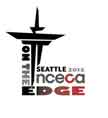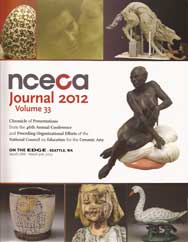Distillations and Eruptions: Ceramics and Installatinon Art - Panel Presentation
On the Edge, NCECA Journal, vol. 33, p. 73-74
National Conference for Education in the Ceramic Arts, Seattle, WA, March 28 - 31, 2012
 As artists, we are in constant dialog with the present and the past as we make work that hopefully speaks to the future. As an artist at the beginning of her career who uses the language of ceramics and installation, I stand on the shoulders of those who came before me while simultaneously distancing myself to find my own voice. In this article I will explore how I view the worlds of ceramics, installation, and the larger art world, and how my choice to use clay interacts with this landscape. As artists, we are in constant dialog with the present and the past as we make work that hopefully speaks to the future. As an artist at the beginning of her career who uses the language of ceramics and installation, I stand on the shoulders of those who came before me while simultaneously distancing myself to find my own voice. In this article I will explore how I view the worlds of ceramics, installation, and the larger art world, and how my choice to use clay interacts with this landscape.
My approach to ceramic installation is a dialogue, and sometimes a tension, between these two words. I am part of a generation of artists who have been influenced by the Minimalists in that we incorporate both space and the viewer in our work: the idea or meaning doesn’t solely lie inside the work itself, but includes both the space and the viewer. I remember reading Michael Fried’s famous 1967 Artforum article, “Art and Objecthood,” defining Minimalist art’s deficiencies as needing the viewer to complete it. When he wrote: “the experience of literalist [Minimalist] art is of an object in a situation – one that, virtually by definition, includes the beholder…including…the beholder’s body,” I knew that that’s what I wanted to achieve. I want my installations to leave an impression that stays with the viewer, thereby transforming them. I want my work to not only be interesting in itself, but to also create a space where the viewer is welcome, where they can have a dialogue with the work as an active participant, not a passive witness.
So how can ceramics add to this experience? Ceramics has the amazing ability to embody opposites simultaneously: brittle and soft; strong and fragile; heavy and light. Its connection to function and daily life are important to me, and are major jumping off points for my work. While I incorporate other media into my installations, ceramic history and conceptual ideas are extremely important. I return to ceramics over and over again because of its ability to convey these associations with daily life and ritual. I believe that the dialog that ceramics can have with such diverse mediums as video, sound and light, make for a unique and powerful conversation.
The installation "In the Wake" is an example of this exchange. In this work, I use the functional form of a vase and its associations in an installation with 106 ceramic vessels covering the floor of a gallery space. The multiple vases create an undulating wave with a curving path in the lull in between. Viewers are invited to walk around and through the arrangement of forms, to experience the sensations of being surrounded by mass and volume, as well as fragility and vulnerability.
One could make the argument that these forms could have been made out of many other materials, but the knowledge that these forms are ceramic provides a universal entry point. We have all seen a ceramic cup or vase holding something, and have memories associated with the form. Vases are capable of holding and capturing. The ceramic forms surrounding the viewer introduce a fear of breaking them as they move throughout the space. I draw on the viewers’ knowledge the vessel and its friability to strengthen their experience of the work.
These pieces aren’t glazed in the traditional sense; instead I redefine the concept of glazing by projecting video that provides a moving glazed surface across the forms. Figures and landscapes drift from one vessel to the next, producing a tension between the images and the static ceramic forms. Each vessel captures only part of the whole image, creating the feeling of an echo of something that has already passed by. While navigating through the space, the viewer becomes a part of the wake, as well as a witness.
"You Only Have What You Remember" is another installation that uses multiple forms, this time to create a landscape exploring the topography of memory. Composed of over a hundred salt bowls, each bowl, empty and waiting, sits on a pedestal that varies in height, forming the personal topography of a bed or a table. There is an indentation in the middle, a reference to a presence long gone. The installation is a place where safety and vulnerability meet in quiet meditation.
In this work, multiple bowls stand in for an action that is repeated over and over again. Our lives are built from these repetitive gestures, with which we form memories. The jump from clay to salt is a small one, as the associations with the body are in both, and my connection to ceramics completely informs this piece, as the imagery is again a functional vessel. Made from a press-mold, each bowl is simple, open and giving. In this way In the Wake and You Only Have What You Remember are two related landscapes.
In the installation "Condensation" currently in the NCECA exhibition “Distillations and Eruptions,” I am playing on ceramic’s fragility yet again, overwhelming the viewer with multiple forms made from paper-thin ceramic. Our minds need to find pattern, symmetry and the familiar, and I instead attempt to throw off the viewer by arranging multiples in such a way as to introduce discord. The dialogue in this piece is with the fragility of the material and the arrangement of the forms. In this way I increase the viewer’s awareness of his or her own body. As they move throughout the space, their relationship to the objects changes with each step, yet they are never able to find the solution, the balance. Ceramics is an essential component in my work whether it is through form (a vessel), the material itself (fragility) or arrangement of multiples (ritual and pattern).
I see my work as part of a trend of ceramic installation artists attempting to break out of the boxes of function, figure, and industry. Amazing in their own right, to think that these are the only paths that ceramics is capable of is unfair, limiting, and disingenuous to this versatile material. Ceramic installations can never completely escape the context and history of the material, and while some may see this as a liability, I take the exact opposite view: these associations have extreme value. The real challenge for the ceramic installation artist is to change the conversation away from how ceramics can elevate itself into the realm of art and break from its past, and instead towards exploring how many ways we can acknowledge its history while at the same gaining from the dialogue of contemporary art. This intersection is a fertile an exciting place to be.
|
|

download article
more texts |

